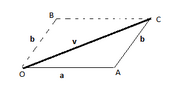A quantity which has magnitude and has some sense of direction is called Vector. For example, force, velocity, acceleration. If a is a vector quantity, it can be represented as or or in bold a . Magnitude of a vector is a positive quantity and is represented as or simply a.
Geometrically, vectors are represented by directed line segments i.e. (by arrows). Length of the arrow represents the magnitude of the vector and the direction of the arrow represents the direction of the vector.
Kinds of Vector[]
Equal Vectors[]
Two given vectors may be equal only when they have the same magnitude and the same direction.
Null Vector[]
AA vector having the initial and the terminal points coincident is termed as a zero vector or a null vector. Thus a null vector has its modulus zero.
Unit Vector[]
A vector having its modulus as unity i.e. equal to 1, is called a unit vector.
If a is a vector and 'a' its modulus, then unit vector a is denoted by defined as:
Polar Vectors[]
The line vectors representing the quantities like force, velocity, etc., in which merely a linear action in a particular direction is involved, are termed as polar vectors.
Axial Vectors[]
The line vectors representing the quantities like angular velocity, angular acceleration, etc., in which some rotational action is involved about an axis and which are drawn parallel to the axis of rotation in order that the magnitude of the quantity is determined by the length of the vector and the direction by the rule of right handed screw(ie, rotation being considered in clockwise direction), are termed as axial vectors.
Free Vector[]
A vector can be represented by an infinite number of equal vectors by drawing parallel supports. Such a vector which can be transported from a place to place such that it remains of the same magnitude and keep up the same direction is termed as a free vector. In fact a free vector is assumed to remain the same through transportation, irrespective of its position in space.
Localised/Line Vector[]
We have defined that the value of a free vector depends only on its length and direction, but if it depends also on its position in space, i.e., if a vector is restricted to pass through a given origin, then it is termed as localised vector.
Collinear Vectors[]
The vectors parallel to the same line, regardless of their magnitudes and sense of directions are termed as collinear vectors. In other words, the vectors having the same or parallel supports are known as collinear vectors. Such vectors are parallel to each other and they may coincide in a special case. As such there exists a scalar ratio say between any two collinear vectors a and b of the form
Non-collinear vectors[]
The vectors whose directions are neither parallel nor coincident are said to be non-collinear.
Like/Co-directional Vectors[]
The vectors which are collinear and have the same sense of directions.
Unlike Vectors[]
The vectors which are collinear but have opposite sense of directions from each other are termed as unlike vectors.
Coplanar Vectors[]
A system of vectors lying in the parallel planes or which can be made to lie in the same plane are said to be coplanar vectors. Evidently any two vectors are always coplanar.
Non-coplanar Vectors[]
A system of vectors consisting of three or more vectors which cannot be made to lie in the same plane are called non-coplanar vectors.
Reciprocal Vector[]
Any vector having its direction the same as that of a given vector a, but its magnitude as the reciprocal of the magnitude of a is termed as the reciprocal vector of a and written as a-1 or . As such
In this connection it is notable that the magnitude and so the recirpocal of the magnitude of a unit vector being unity, the unit vector is reciprocal to itself and it is said to be self-reciprocal.
Negative Vector[]
The vector having the same magnitude as the vector a but opposite direction, is known as the negative of a and written as —a.
Positive Vector[]
If a vector OP specifies the position of a point relative to an arbitrarily chosen point O, then OP is called the Position vector of P with respect to O, the origin of vectors.
Addition of Vectors[]

Parallelogram law of addition
The characterisation of process of summation is inherited in the composition of two or more displacements of a point. Suppose that we have two vectors a and b acting at a point O as shown in figure. Let and .
v =
The result of adding two co-initial vectors is the vector represented by the diagonal of the parallelogram having two vectors as its adjacent sides.













